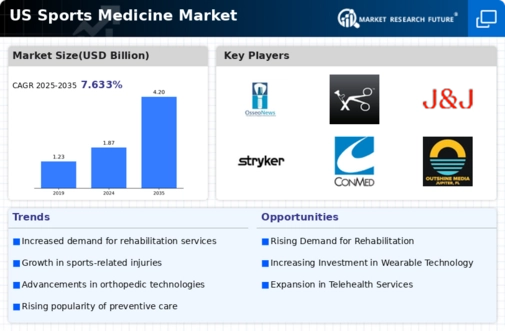Increasing Participation in Sports
The growing inclination towards sports and fitness activities among various demographics is a primary driver for the sports medicine market. As more individuals engage in sports, the incidence of sports-related injuries rises, necessitating medical intervention. According to recent data, approximately 30 million children and adolescents participate in organized sports in the US, leading to a heightened demand for sports medicine services. This trend is further supported by the increasing awareness of health and fitness, which encourages individuals to seek preventive care and treatment for injuries. Consequently, the sports medicine market is experiencing a surge in demand for specialized services, including injury prevention, rehabilitation, and performance enhancement.
Rising Awareness of Sports Injuries
There is a growing awareness of sports injuries and their long-term implications among athletes and the general public, which serves as a significant driver for the sports medicine market. Educational campaigns and media coverage have highlighted the importance of proper treatment and rehabilitation for sports injuries. This heightened awareness encourages individuals to seek medical attention promptly, thereby increasing the demand for sports medicine services. Furthermore, the sports medicine market is witnessing a shift towards preventive measures, as athletes and recreational participants alike recognize the value of injury prevention strategies. This trend is likely to continue, fostering a culture of proactive health management.
Aging Population and Active Lifestyles
The aging population in the US is increasingly adopting active lifestyles, which significantly impacts the sports medicine market. Older adults are participating in sports and physical activities to maintain their health and well-being. This demographic shift has led to a rise in age-related injuries, such as joint pain and muscle strains, creating a demand for specialized medical services. Reports indicate that by 2030, nearly 20% of the US population will be over 65 years old, further emphasizing the need for tailored sports medicine solutions. The sports medicine market is thus adapting to cater to this demographic, focusing on injury prevention, rehabilitation, and enhancing the quality of life for older athletes.
Technological Advancements in Treatment Options
Technological advancements in treatment options are transforming the sports medicine market, providing innovative solutions for injury management and rehabilitation. The integration of cutting-edge technologies, such as telemedicine, wearable devices, and advanced imaging techniques, enhances the ability to diagnose and treat sports-related injuries effectively. For instance, the use of wearable technology allows for real-time monitoring of athletes' performance and health metrics, facilitating timely interventions. As these technologies become more accessible, the sports medicine market is likely to expand, driven by the demand for efficient and effective treatment options that cater to the evolving needs of athletes.
Growth of Sports Medicine Education and Training Programs
The expansion of educational and training programs in sports medicine is a crucial driver for the sports medicine market. As the demand for qualified professionals increases, educational institutions are developing specialized programs to train healthcare providers in sports-related injuries and treatments. This trend is evident in the rise of accredited sports medicine programs across the US, which aim to equip practitioners with the necessary skills to address the unique needs of athletes. The sports medicine market benefits from this growth, as a well-trained workforce enhances the quality of care provided to patients, ultimately leading to improved outcomes and increased market demand.



















Leave a Comment